Fujikura Ltd. has introduced a highly integrated phased array antenna module (PAAM) for the 5G mmWave bands: n257 (28 GHz), n258 (26 GHz) and n261 (27 GHz). The company plans to sample PAAMs to selected customers by the end of the first quarter of 2021 and support volume production during the second half of 2021.
The PAAM includes the antenna and supports concurrent dual-polarized beams in both transmit and receive. The mmWave RFICs in the module were developed by Fujikura using a SiGe BiCMOS process.

The PAAM is digitally reconfigurable to meet the requirements of the application. For example, noise figure and linearity can be traded, setting the lowest noise to maximize the link margin and expand coverage. The programmability also supports thousands of beam configurations on-chip.
The phase shifters are tunable to achieve fine resolution and provide true time delay, maintaining the transmit or receive beam direction across a wide frequency range. The phase shifter design enables simple beam steering control and calibration-free operation. The PAAM also has independent amplitude control.
Kenji Nishide, Fujikura’s executive officer responsible for R&D, said, “Leveraging our expertise in antenna design and substrate technologies, as well as our long history and expertise in delivering differentiating products to the telecom industry, we are excited to introduce our new PAAM product family.”
Nishide says the design is the industry’s highest performance phased array antenna module for 5G indoor and outdoor applications. It leverages mmWave RFIC and antenna-in-package technologies developed at IBM Research, licensed by Fujikura, and first applied to develop a 60 GHz communications module.
Founded in 1885 and based in Tokyo, Fujikura has long been a supplier of wires and cables, expanding its vision to encompass Tsunagu — connecting — technologies.
